ECON111: Microeconomic Impact of Minimum Wage Legislation S2
VerifiedAdded on 2023/06/04
|16
|2459
|279
Homework Assignment
AI Summary
This assignment provides a comprehensive analysis of minimum wage legislation within a microeconomic framework. It begins by defining minimum wage as a price floor and explores its intended purpose of protecting workers from exploitation. The assignment then calculates the equilibrium wage rate and quantity of labor, followed by a graphical representation of the labor market's supply and demand curves. It examines consumer and producer surplus, total surplus, and the impact of a minimum wage of $19 per hour. The analysis includes calculations of surplus changes, deadweight loss, and resources lost in job searches, assessing the welfare effects on consumers, producers, and society as a whole. Furthermore, it delves into ethical justifications for and against minimum wage based on its impact on income inequality and the principles of Deontology, ultimately evaluating the policy's overall efficiency and fairness. The study also evaluates the impact on consumer and producer surplus when workers are better off than before. The assignment concludes that minimum wage diminishes the total surplus of the society.
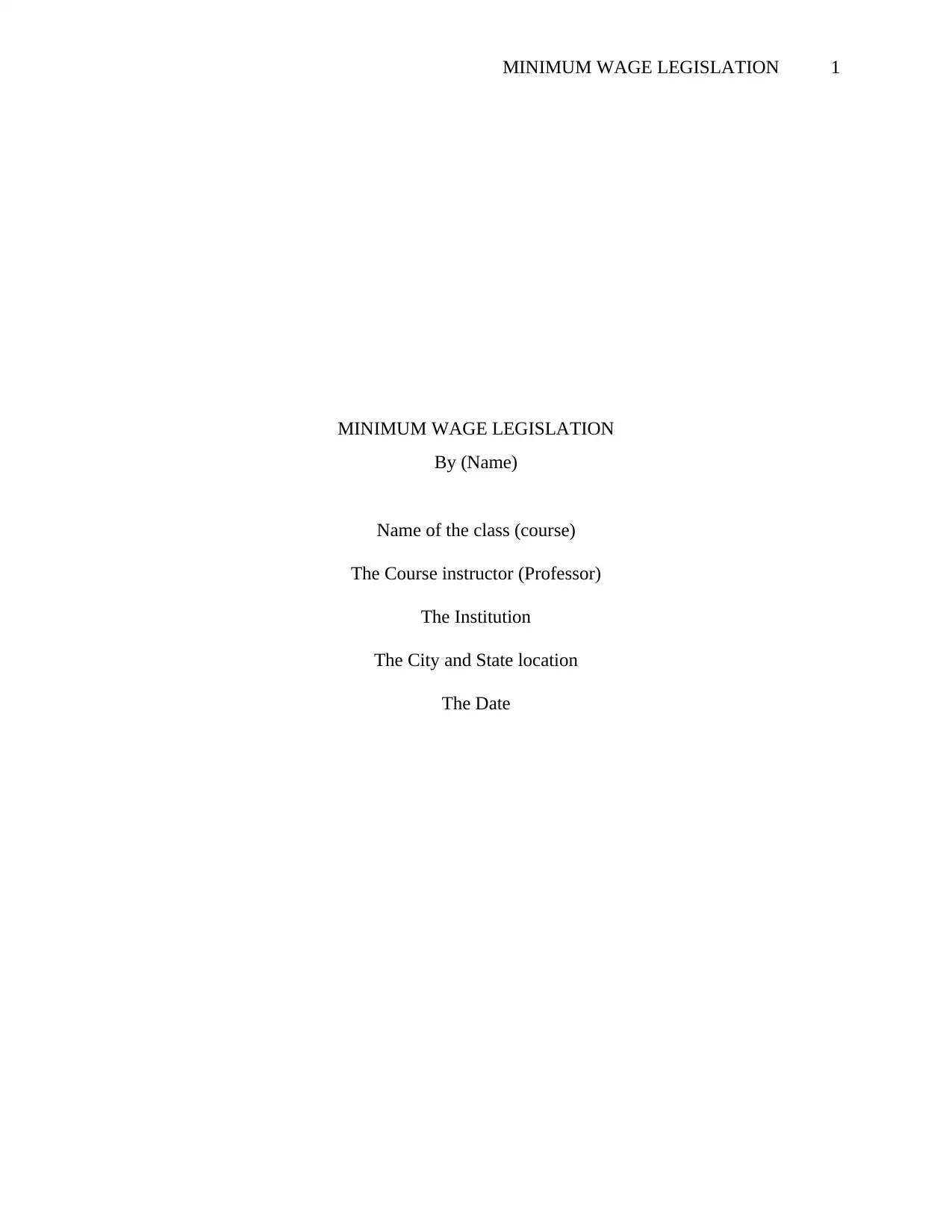
MINIMUM WAGE LEGISLATION 1
MINIMUM WAGE LEGISLATION
By (Name)
Name of the class (course)
The Course instructor (Professor)
The Institution
The City and State location
The Date
MINIMUM WAGE LEGISLATION
By (Name)
Name of the class (course)
The Course instructor (Professor)
The Institution
The City and State location
The Date
Paraphrase This Document
Need a fresh take? Get an instant paraphrase of this document with our AI Paraphraser

MINIMUM WAGE LEGISLATION 2
Q1.
Minimum wage falls under the category of price control known as a price floor. This type of
price floor stipulates the lowest wages an employee can receive as compensation for labor
provided (Case et al., 2014, p.54). Therefore, the enactment of minimum wage legislation is
meant to protect the interest of workers so that the employers do not exploit them. For minimum
wage to bind, it must be set above the market equilibrium wage rate. If it set below the market
equilibrium, it will be ineffective and will not influence the market due to the price mechanism.
Q2.
Australia’s minimum wage rate is 18.93 dollars per hour (Fair Work Ombudsman, 2018).
Q3.
At equilibrium, Quantity supplied (Qs) equals the Quantity demanded (Qd)
Qd = 1,500,000 – 60,000W
QS = 120,000W – 1,200,000
Therefore,
1,500,000 – 60,000W = 120,000W – 1,200,000
Collect the like terms together
-60,000W - 120,000W = – 1,200,000 - 1,500,000
-180,000W = -2,700,000
W = -2,700,000 / -180,000
Q1.
Minimum wage falls under the category of price control known as a price floor. This type of
price floor stipulates the lowest wages an employee can receive as compensation for labor
provided (Case et al., 2014, p.54). Therefore, the enactment of minimum wage legislation is
meant to protect the interest of workers so that the employers do not exploit them. For minimum
wage to bind, it must be set above the market equilibrium wage rate. If it set below the market
equilibrium, it will be ineffective and will not influence the market due to the price mechanism.
Q2.
Australia’s minimum wage rate is 18.93 dollars per hour (Fair Work Ombudsman, 2018).
Q3.
At equilibrium, Quantity supplied (Qs) equals the Quantity demanded (Qd)
Qd = 1,500,000 – 60,000W
QS = 120,000W – 1,200,000
Therefore,
1,500,000 – 60,000W = 120,000W – 1,200,000
Collect the like terms together
-60,000W - 120,000W = – 1,200,000 - 1,500,000
-180,000W = -2,700,000
W = -2,700,000 / -180,000
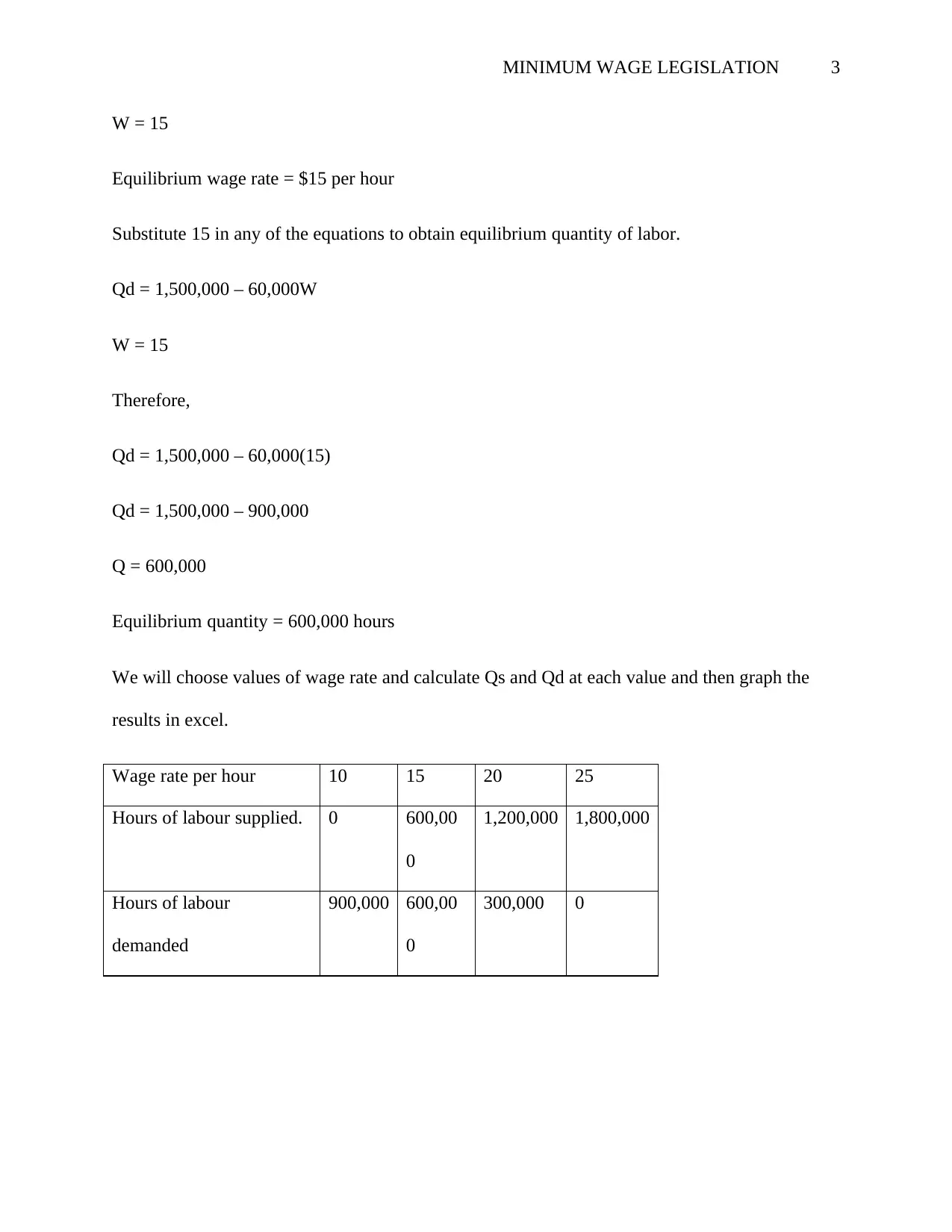
MINIMUM WAGE LEGISLATION 3
W = 15
Equilibrium wage rate = $15 per hour
Substitute 15 in any of the equations to obtain equilibrium quantity of labor.
Qd = 1,500,000 – 60,000W
W = 15
Therefore,
Qd = 1,500,000 – 60,000(15)
Qd = 1,500,000 – 900,000
Q = 600,000
Equilibrium quantity = 600,000 hours
We will choose values of wage rate and calculate Qs and Qd at each value and then graph the
results in excel.
Wage rate per hour 10 15 20 25
Hours of labour supplied. 0 600,00
0
1,200,000 1,800,000
Hours of labour
demanded
900,000 600,00
0
300,000 0
W = 15
Equilibrium wage rate = $15 per hour
Substitute 15 in any of the equations to obtain equilibrium quantity of labor.
Qd = 1,500,000 – 60,000W
W = 15
Therefore,
Qd = 1,500,000 – 60,000(15)
Qd = 1,500,000 – 900,000
Q = 600,000
Equilibrium quantity = 600,000 hours
We will choose values of wage rate and calculate Qs and Qd at each value and then graph the
results in excel.
Wage rate per hour 10 15 20 25
Hours of labour supplied. 0 600,00
0
1,200,000 1,800,000
Hours of labour
demanded
900,000 600,00
0
300,000 0
⊘ This is a preview!⊘
Do you want full access?
Subscribe today to unlock all pages.

Trusted by 1+ million students worldwide
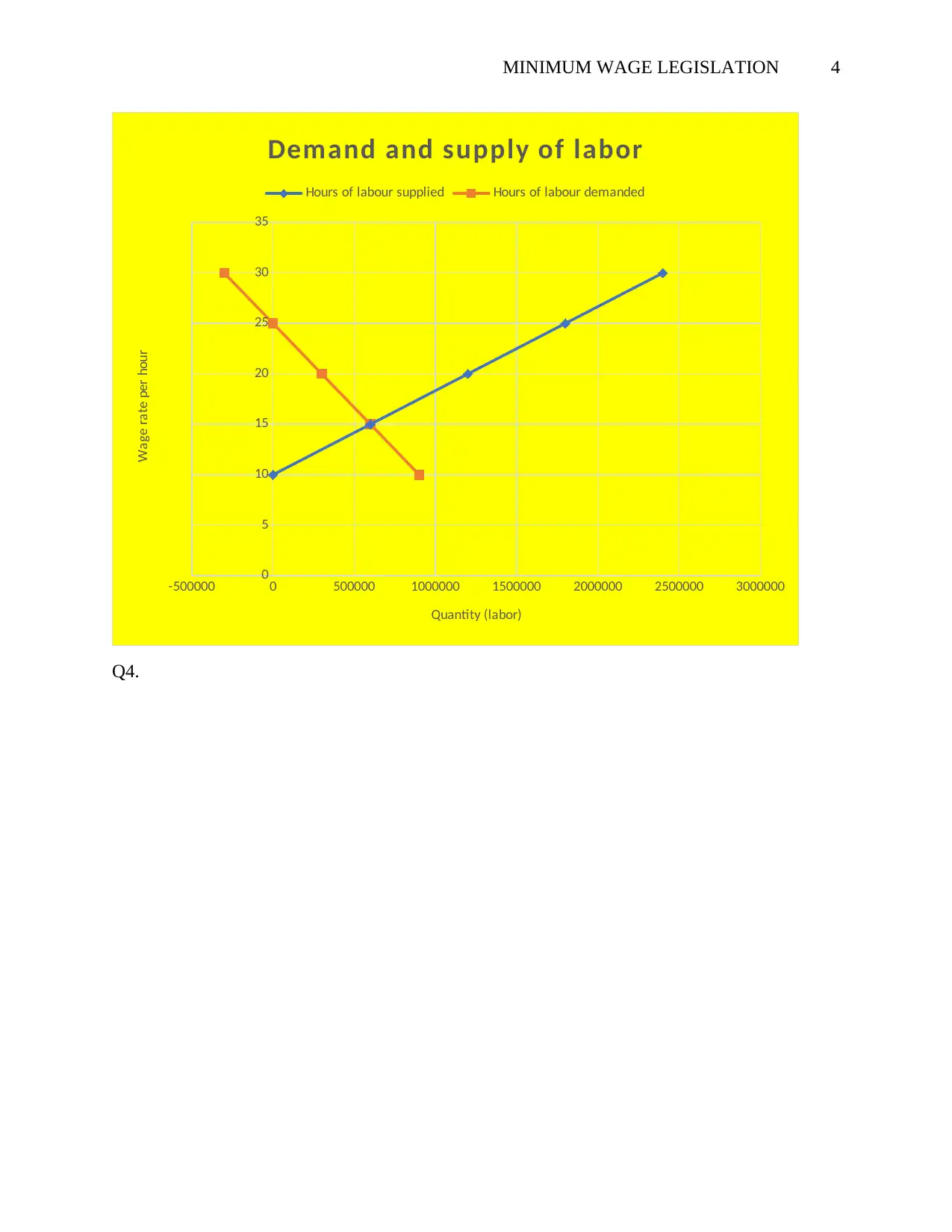
MINIMUM WAGE LEGISLATION 4
-500000 0 500000 1000000 1500000 2000000 2500000 3000000
0
5
10
15
20
25
30
35
Demand and supply of labor
Hours of labour supplied Hours of labour demanded
Quantity (labor)
Wage rate per hour
Q4.
-500000 0 500000 1000000 1500000 2000000 2500000 3000000
0
5
10
15
20
25
30
35
Demand and supply of labor
Hours of labour supplied Hours of labour demanded
Quantity (labor)
Wage rate per hour
Q4.
Paraphrase This Document
Need a fresh take? Get an instant paraphrase of this document with our AI Paraphraser

MINIMUM WAGE LEGISLATION 5
-500000 0 500000 1000000 1500000 2000000 2500000 3000000
0
5
10
15
20
25
30
35
Demand and supply of labor
Hours of labour supplied Hours of labour demanded
Quantity (labor)
Wage rate per hour
i.
Consumer surplus is shown by the area shaded orange. This surplus is given as the area below
the demand curve and above the market clearing wage rate.
Mathematically, consumer surplus is given as ½ base * height
Base = 600,000
Height = 25 – 15 = 10
Hence
Consumer surplus = ½ * 600,000 * 10 = $3,000,000
ii.
-500000 0 500000 1000000 1500000 2000000 2500000 3000000
0
5
10
15
20
25
30
35
Demand and supply of labor
Hours of labour supplied Hours of labour demanded
Quantity (labor)
Wage rate per hour
i.
Consumer surplus is shown by the area shaded orange. This surplus is given as the area below
the demand curve and above the market clearing wage rate.
Mathematically, consumer surplus is given as ½ base * height
Base = 600,000
Height = 25 – 15 = 10
Hence
Consumer surplus = ½ * 600,000 * 10 = $3,000,000
ii.
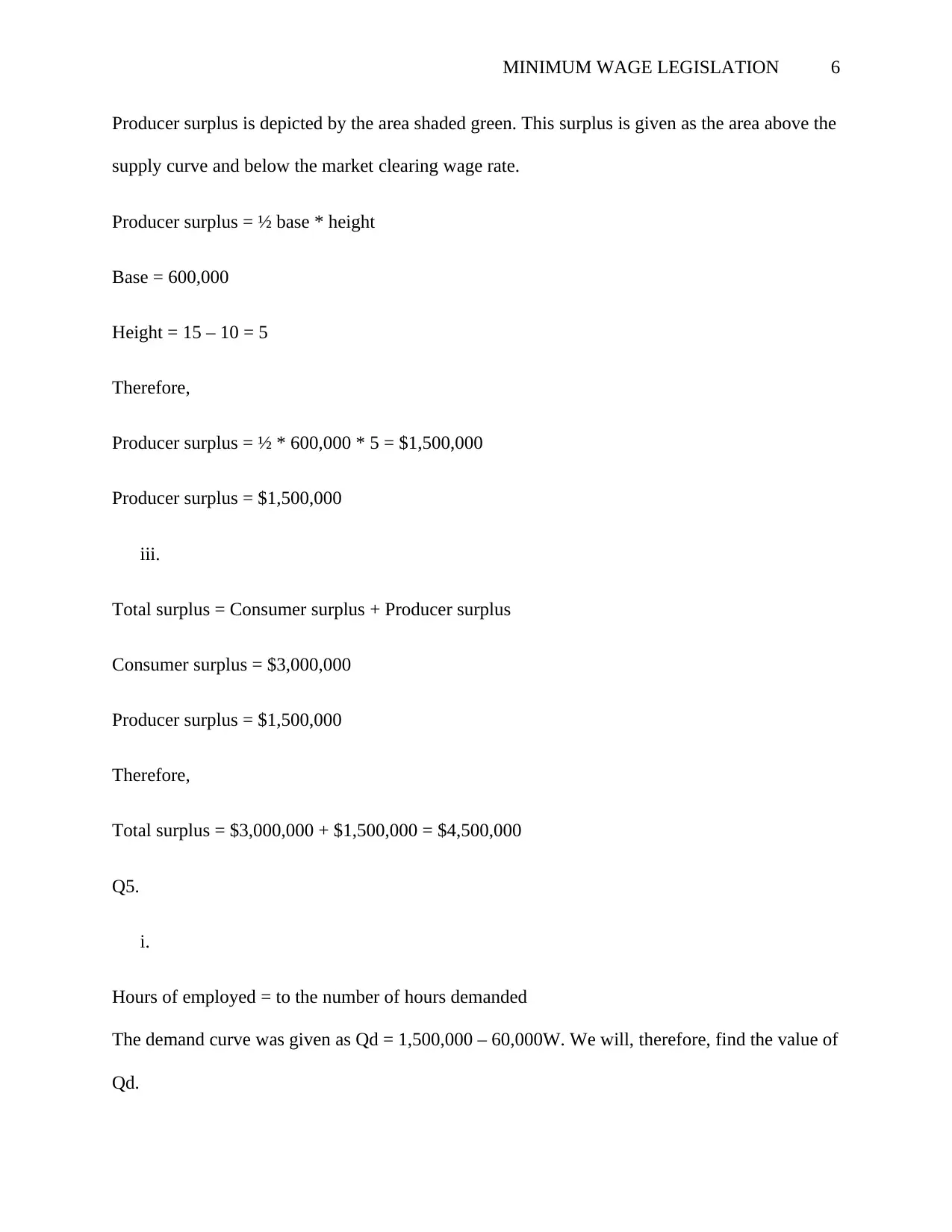
MINIMUM WAGE LEGISLATION 6
Producer surplus is depicted by the area shaded green. This surplus is given as the area above the
supply curve and below the market clearing wage rate.
Producer surplus = ½ base * height
Base = 600,000
Height = 15 – 10 = 5
Therefore,
Producer surplus = ½ * 600,000 * 5 = $1,500,000
Producer surplus = $1,500,000
iii.
Total surplus = Consumer surplus + Producer surplus
Consumer surplus = $3,000,000
Producer surplus = $1,500,000
Therefore,
Total surplus = $3,000,000 + $1,500,000 = $4,500,000
Q5.
i.
Hours of employed = to the number of hours demanded
The demand curve was given as Qd = 1,500,000 – 60,000W. We will, therefore, find the value of
Qd.
Producer surplus is depicted by the area shaded green. This surplus is given as the area above the
supply curve and below the market clearing wage rate.
Producer surplus = ½ base * height
Base = 600,000
Height = 15 – 10 = 5
Therefore,
Producer surplus = ½ * 600,000 * 5 = $1,500,000
Producer surplus = $1,500,000
iii.
Total surplus = Consumer surplus + Producer surplus
Consumer surplus = $3,000,000
Producer surplus = $1,500,000
Therefore,
Total surplus = $3,000,000 + $1,500,000 = $4,500,000
Q5.
i.
Hours of employed = to the number of hours demanded
The demand curve was given as Qd = 1,500,000 – 60,000W. We will, therefore, find the value of
Qd.
⊘ This is a preview!⊘
Do you want full access?
Subscribe today to unlock all pages.

Trusted by 1+ million students worldwide
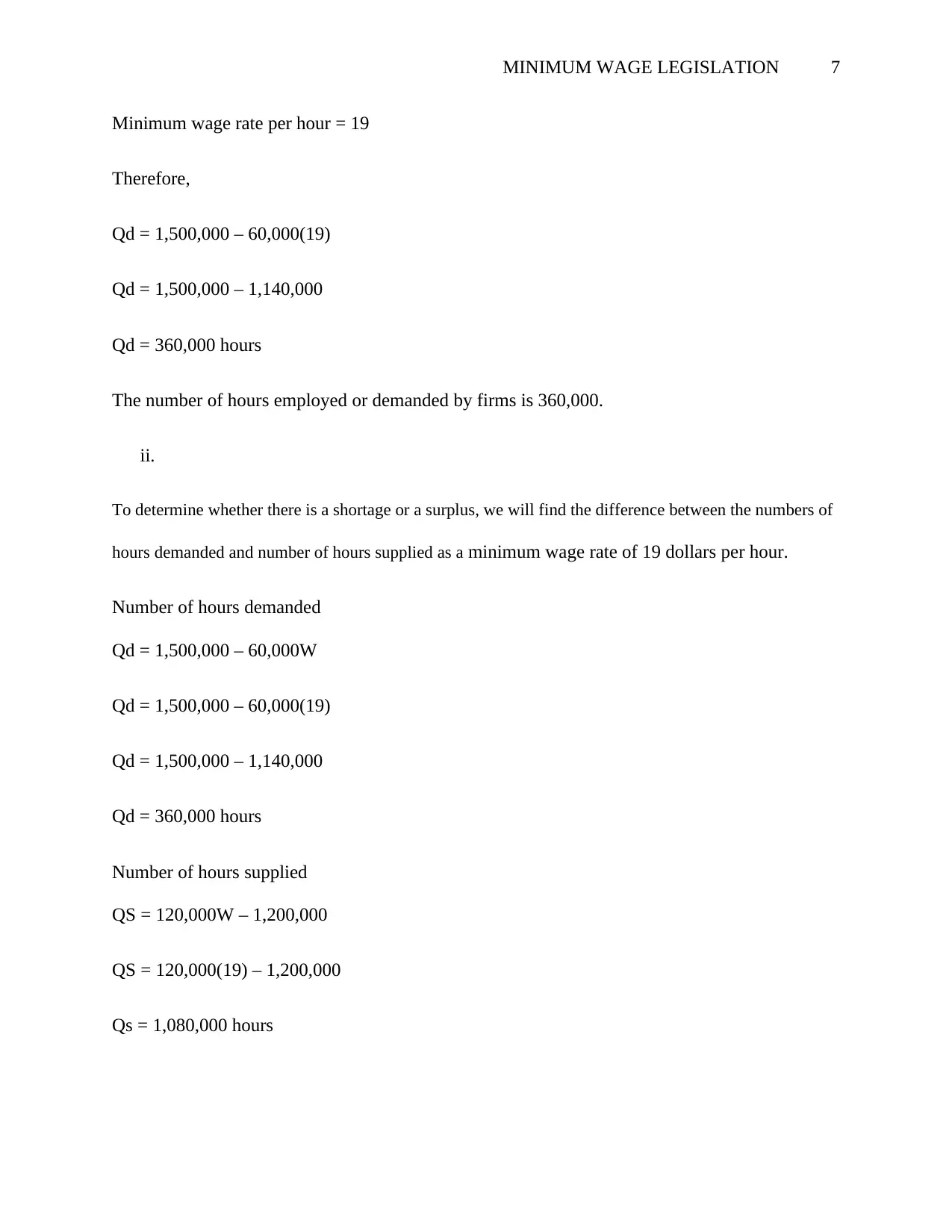
MINIMUM WAGE LEGISLATION 7
Minimum wage rate per hour = 19
Therefore,
Qd = 1,500,000 – 60,000(19)
Qd = 1,500,000 – 1,140,000
Qd = 360,000 hours
The number of hours employed or demanded by firms is 360,000.
ii.
To determine whether there is a shortage or a surplus, we will find the difference between the numbers of
hours demanded and number of hours supplied as a minimum wage rate of 19 dollars per hour.
Number of hours demanded
Qd = 1,500,000 – 60,000W
Qd = 1,500,000 – 60,000(19)
Qd = 1,500,000 – 1,140,000
Qd = 360,000 hours
Number of hours supplied
QS = 120,000W – 1,200,000
QS = 120,000(19) – 1,200,000
Qs = 1,080,000 hours
Minimum wage rate per hour = 19
Therefore,
Qd = 1,500,000 – 60,000(19)
Qd = 1,500,000 – 1,140,000
Qd = 360,000 hours
The number of hours employed or demanded by firms is 360,000.
ii.
To determine whether there is a shortage or a surplus, we will find the difference between the numbers of
hours demanded and number of hours supplied as a minimum wage rate of 19 dollars per hour.
Number of hours demanded
Qd = 1,500,000 – 60,000W
Qd = 1,500,000 – 60,000(19)
Qd = 1,500,000 – 1,140,000
Qd = 360,000 hours
Number of hours supplied
QS = 120,000W – 1,200,000
QS = 120,000(19) – 1,200,000
Qs = 1,080,000 hours
Paraphrase This Document
Need a fresh take? Get an instant paraphrase of this document with our AI Paraphraser
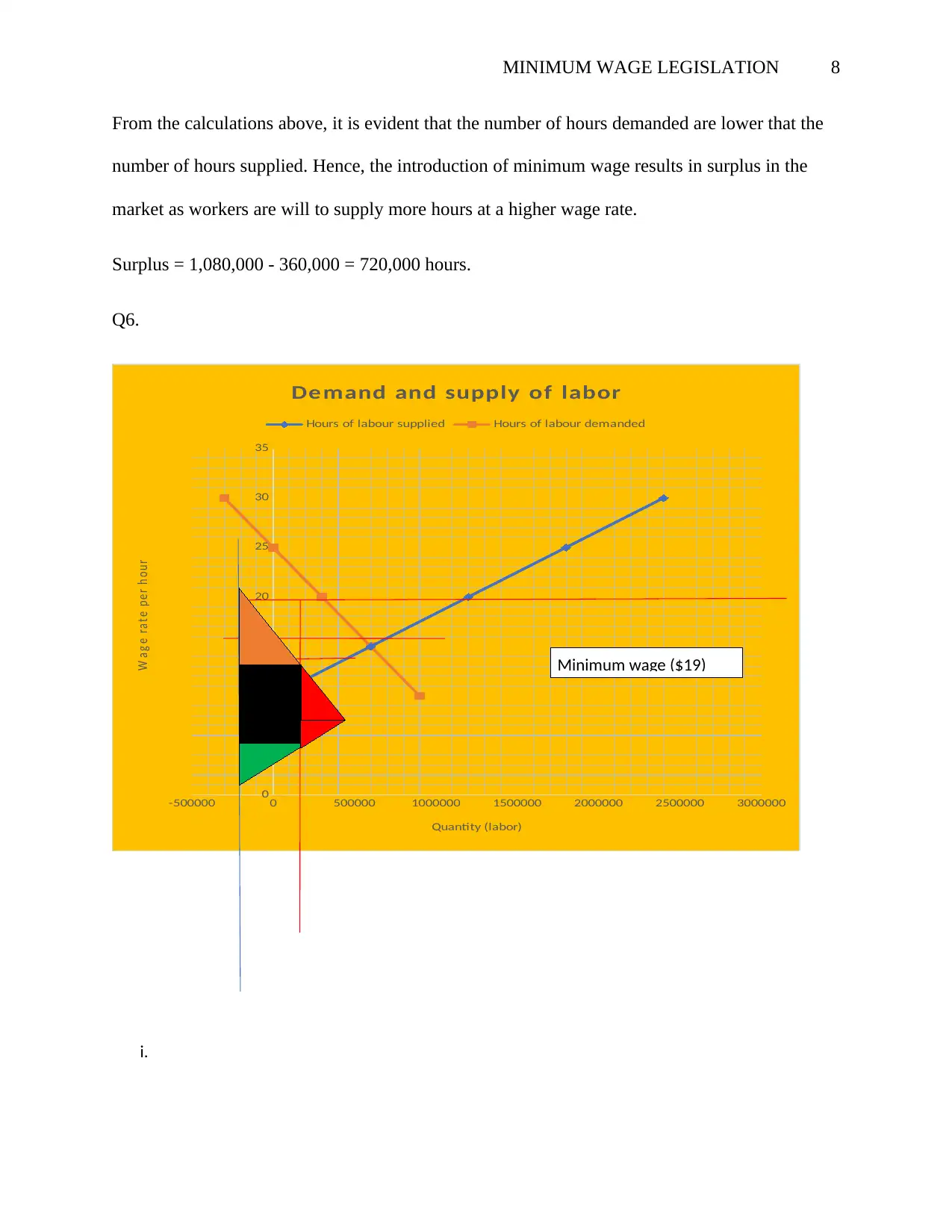
MINIMUM WAGE LEGISLATION 8
From the calculations above, it is evident that the number of hours demanded are lower that the
number of hours supplied. Hence, the introduction of minimum wage results in surplus in the
market as workers are will to supply more hours at a higher wage rate.
Surplus = 1,080,000 - 360,000 = 720,000 hours.
Q6.
-500000 0 500000 1000000 1500000 2000000 2500000 3000000
0
5
10
15
20
25
30
35
Demand and supply of labor
Hours of labour supplied Hours of labour demanded
Quantity (labor)
W a g e ra te p e r h ou r
i.
Minimum wage ($19)
From the calculations above, it is evident that the number of hours demanded are lower that the
number of hours supplied. Hence, the introduction of minimum wage results in surplus in the
market as workers are will to supply more hours at a higher wage rate.
Surplus = 1,080,000 - 360,000 = 720,000 hours.
Q6.
-500000 0 500000 1000000 1500000 2000000 2500000 3000000
0
5
10
15
20
25
30
35
Demand and supply of labor
Hours of labour supplied Hours of labour demanded
Quantity (labor)
W a g e ra te p e r h ou r
i.
Minimum wage ($19)
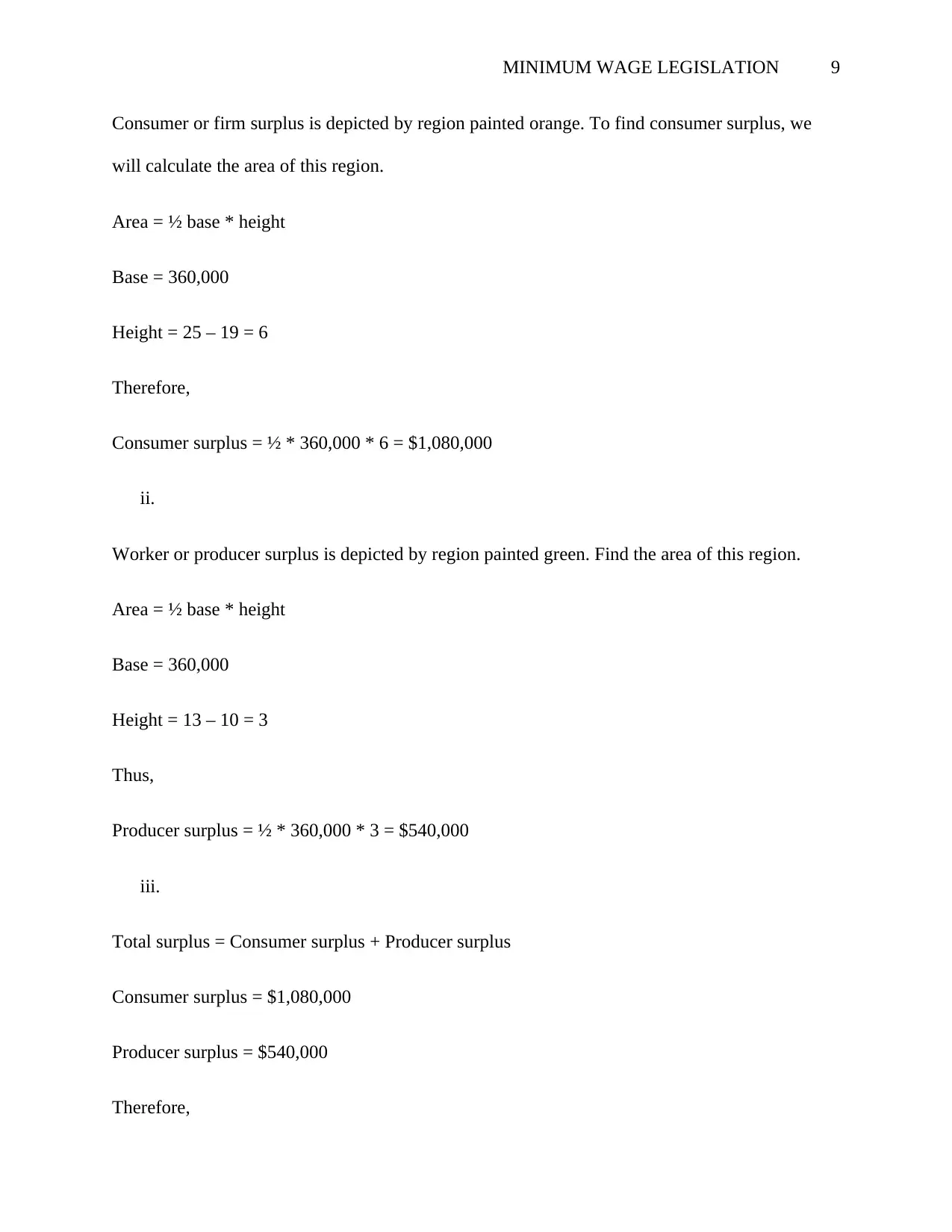
MINIMUM WAGE LEGISLATION 9
Consumer or firm surplus is depicted by region painted orange. To find consumer surplus, we
will calculate the area of this region.
Area = ½ base * height
Base = 360,000
Height = 25 – 19 = 6
Therefore,
Consumer surplus = ½ * 360,000 * 6 = $1,080,000
ii.
Worker or producer surplus is depicted by region painted green. Find the area of this region.
Area = ½ base * height
Base = 360,000
Height = 13 – 10 = 3
Thus,
Producer surplus = ½ * 360,000 * 3 = $540,000
iii.
Total surplus = Consumer surplus + Producer surplus
Consumer surplus = $1,080,000
Producer surplus = $540,000
Therefore,
Consumer or firm surplus is depicted by region painted orange. To find consumer surplus, we
will calculate the area of this region.
Area = ½ base * height
Base = 360,000
Height = 25 – 19 = 6
Therefore,
Consumer surplus = ½ * 360,000 * 6 = $1,080,000
ii.
Worker or producer surplus is depicted by region painted green. Find the area of this region.
Area = ½ base * height
Base = 360,000
Height = 13 – 10 = 3
Thus,
Producer surplus = ½ * 360,000 * 3 = $540,000
iii.
Total surplus = Consumer surplus + Producer surplus
Consumer surplus = $1,080,000
Producer surplus = $540,000
Therefore,
⊘ This is a preview!⊘
Do you want full access?
Subscribe today to unlock all pages.

Trusted by 1+ million students worldwide
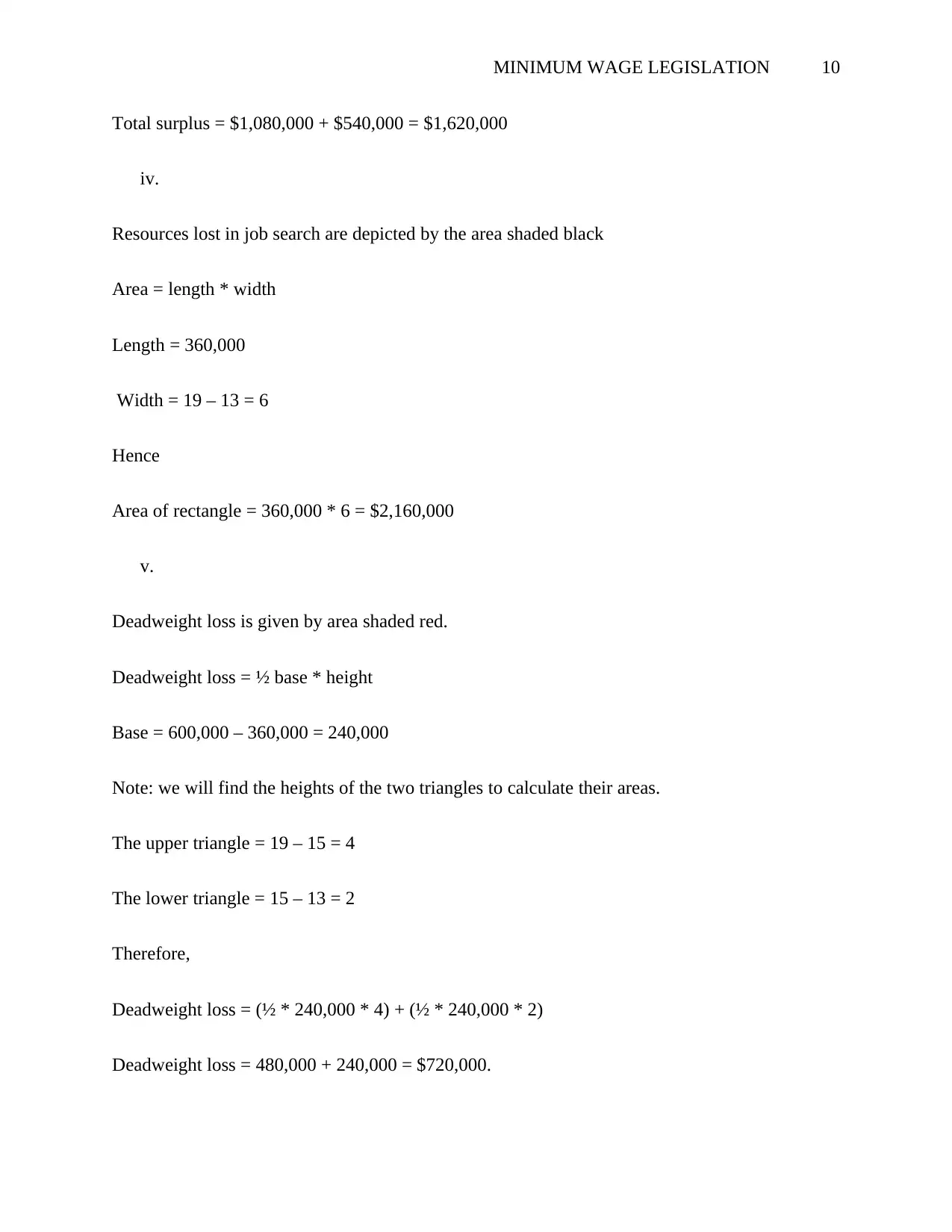
MINIMUM WAGE LEGISLATION 10
Total surplus = $1,080,000 + $540,000 = $1,620,000
iv.
Resources lost in job search are depicted by the area shaded black
Area = length * width
Length = 360,000
Width = 19 – 13 = 6
Hence
Area of rectangle = 360,000 * 6 = $2,160,000
v.
Deadweight loss is given by area shaded red.
Deadweight loss = ½ base * height
Base = 600,000 – 360,000 = 240,000
Note: we will find the heights of the two triangles to calculate their areas.
The upper triangle = 19 – 15 = 4
The lower triangle = 15 – 13 = 2
Therefore,
Deadweight loss = (½ * 240,000 * 4) + (½ * 240,000 * 2)
Deadweight loss = 480,000 + 240,000 = $720,000.
Total surplus = $1,080,000 + $540,000 = $1,620,000
iv.
Resources lost in job search are depicted by the area shaded black
Area = length * width
Length = 360,000
Width = 19 – 13 = 6
Hence
Area of rectangle = 360,000 * 6 = $2,160,000
v.
Deadweight loss is given by area shaded red.
Deadweight loss = ½ base * height
Base = 600,000 – 360,000 = 240,000
Note: we will find the heights of the two triangles to calculate their areas.
The upper triangle = 19 – 15 = 4
The lower triangle = 15 – 13 = 2
Therefore,
Deadweight loss = (½ * 240,000 * 4) + (½ * 240,000 * 2)
Deadweight loss = 480,000 + 240,000 = $720,000.
Paraphrase This Document
Need a fresh take? Get an instant paraphrase of this document with our AI Paraphraser
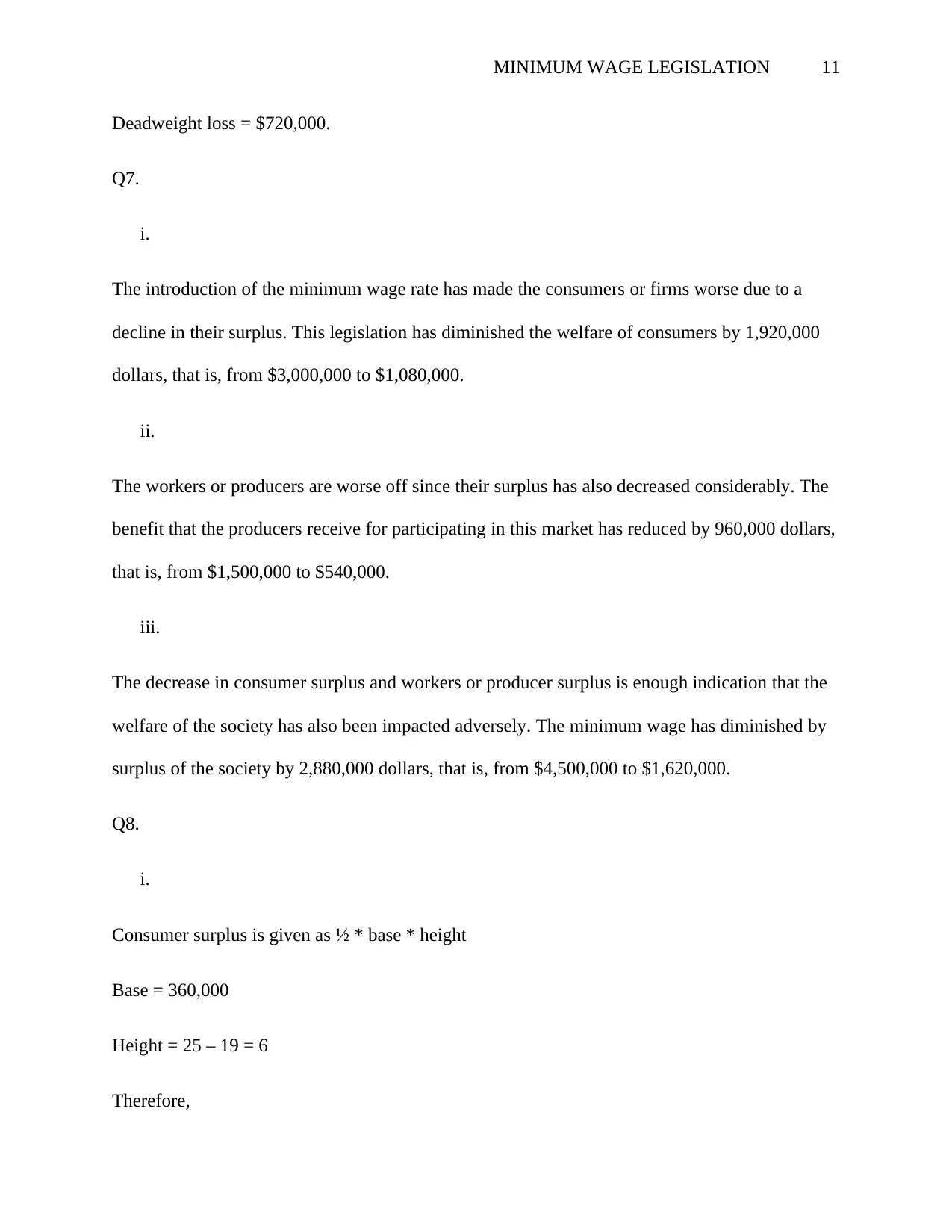
MINIMUM WAGE LEGISLATION 11
Deadweight loss = $720,000.
Q7.
i.
The introduction of the minimum wage rate has made the consumers or firms worse due to a
decline in their surplus. This legislation has diminished the welfare of consumers by 1,920,000
dollars, that is, from $3,000,000 to $1,080,000.
ii.
The workers or producers are worse off since their surplus has also decreased considerably. The
benefit that the producers receive for participating in this market has reduced by 960,000 dollars,
that is, from $1,500,000 to $540,000.
iii.
The decrease in consumer surplus and workers or producer surplus is enough indication that the
welfare of the society has also been impacted adversely. The minimum wage has diminished by
surplus of the society by 2,880,000 dollars, that is, from $4,500,000 to $1,620,000.
Q8.
i.
Consumer surplus is given as ½ * base * height
Base = 360,000
Height = 25 – 19 = 6
Therefore,
Deadweight loss = $720,000.
Q7.
i.
The introduction of the minimum wage rate has made the consumers or firms worse due to a
decline in their surplus. This legislation has diminished the welfare of consumers by 1,920,000
dollars, that is, from $3,000,000 to $1,080,000.
ii.
The workers or producers are worse off since their surplus has also decreased considerably. The
benefit that the producers receive for participating in this market has reduced by 960,000 dollars,
that is, from $1,500,000 to $540,000.
iii.
The decrease in consumer surplus and workers or producer surplus is enough indication that the
welfare of the society has also been impacted adversely. The minimum wage has diminished by
surplus of the society by 2,880,000 dollars, that is, from $4,500,000 to $1,620,000.
Q8.
i.
Consumer surplus is given as ½ * base * height
Base = 360,000
Height = 25 – 19 = 6
Therefore,
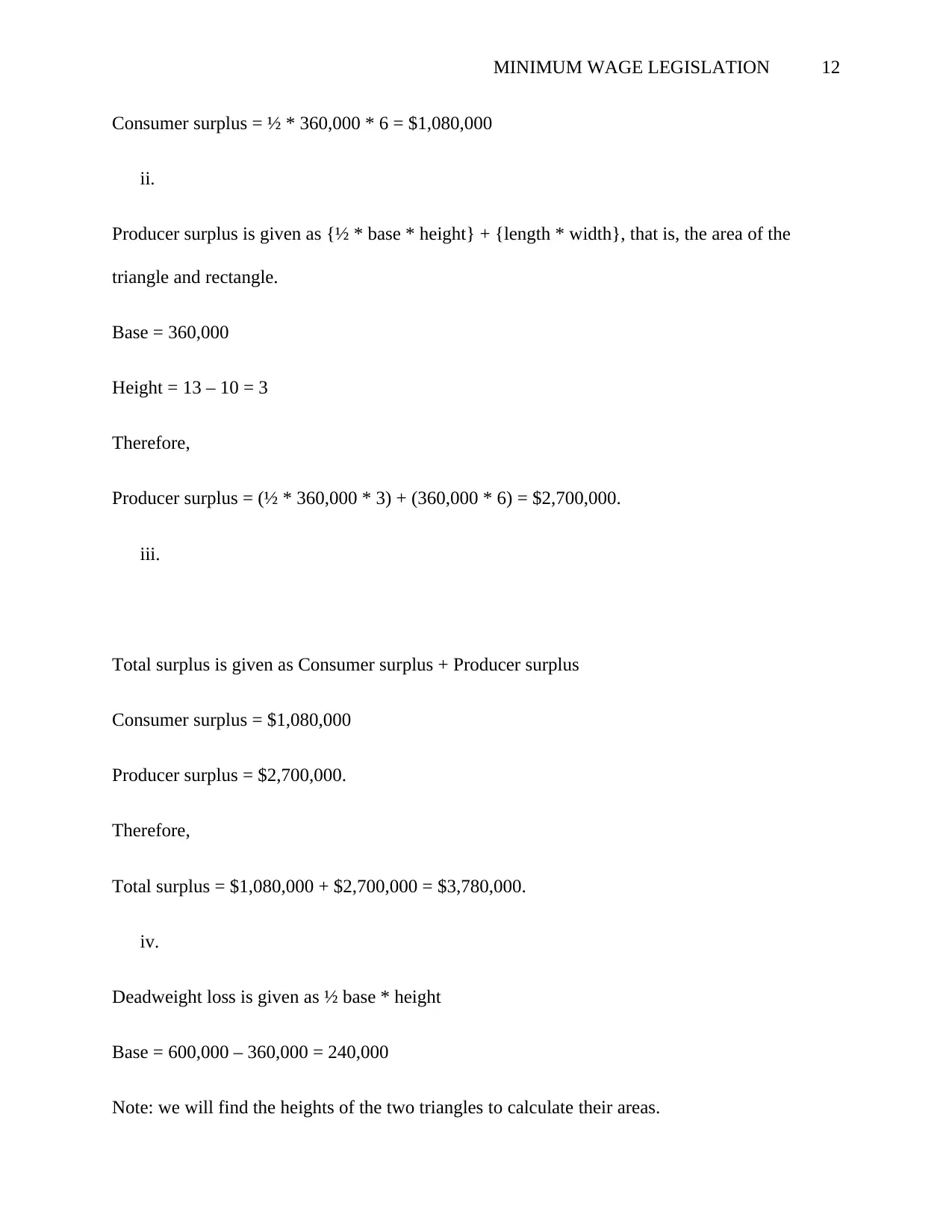
MINIMUM WAGE LEGISLATION 12
Consumer surplus = ½ * 360,000 * 6 = $1,080,000
ii.
Producer surplus is given as {½ * base * height} + {length * width}, that is, the area of the
triangle and rectangle.
Base = 360,000
Height = 13 – 10 = 3
Therefore,
Producer surplus = (½ * 360,000 * 3) + (360,000 * 6) = $2,700,000.
iii.
Total surplus is given as Consumer surplus + Producer surplus
Consumer surplus = $1,080,000
Producer surplus = $2,700,000.
Therefore,
Total surplus = $1,080,000 + $2,700,000 = $3,780,000.
iv.
Deadweight loss is given as ½ base * height
Base = 600,000 – 360,000 = 240,000
Note: we will find the heights of the two triangles to calculate their areas.
Consumer surplus = ½ * 360,000 * 6 = $1,080,000
ii.
Producer surplus is given as {½ * base * height} + {length * width}, that is, the area of the
triangle and rectangle.
Base = 360,000
Height = 13 – 10 = 3
Therefore,
Producer surplus = (½ * 360,000 * 3) + (360,000 * 6) = $2,700,000.
iii.
Total surplus is given as Consumer surplus + Producer surplus
Consumer surplus = $1,080,000
Producer surplus = $2,700,000.
Therefore,
Total surplus = $1,080,000 + $2,700,000 = $3,780,000.
iv.
Deadweight loss is given as ½ base * height
Base = 600,000 – 360,000 = 240,000
Note: we will find the heights of the two triangles to calculate their areas.
⊘ This is a preview!⊘
Do you want full access?
Subscribe today to unlock all pages.

Trusted by 1+ million students worldwide
1 out of 16
Related Documents
Your All-in-One AI-Powered Toolkit for Academic Success.
+13062052269
info@desklib.com
Available 24*7 on WhatsApp / Email
![[object Object]](/_next/static/media/star-bottom.7253800d.svg)
Unlock your academic potential
Copyright © 2020–2025 A2Z Services. All Rights Reserved. Developed and managed by ZUCOL.



